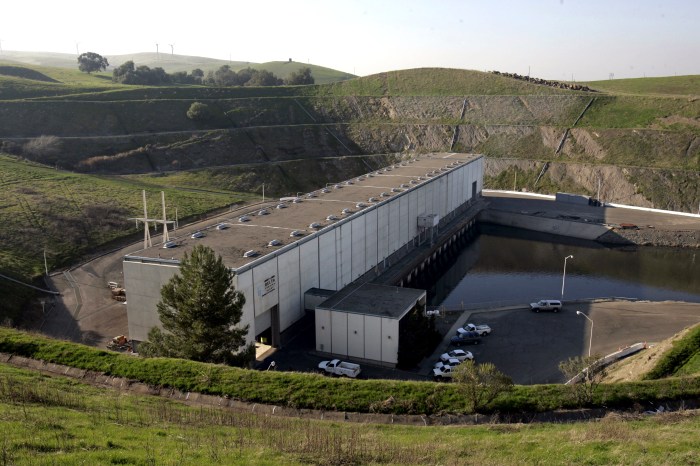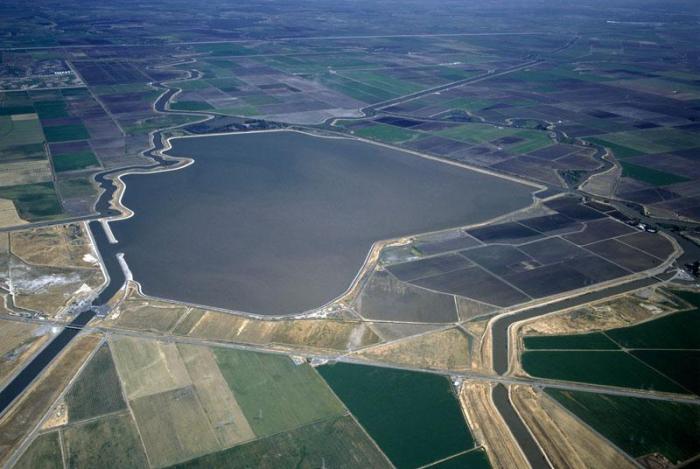Harvey o banks pumping plant – Step into the world of the Harvey O. Banks Pumping Plant, an engineering marvel that stands as a testament to human ingenuity. This remarkable facility plays a pivotal role in managing the water resources of California, shaping the landscape and powering communities.
At the heart of the Sacramento-San Joaquin Delta, the Harvey O. Banks Pumping Plant is a symphony of pumps, turbines, and infrastructure, working in harmony to meet the water conveyance needs of the region.
Harvey O. Banks Pumping Plant History
The Harvey O. Banks Pumping Plant is a massive water pumping station located in the Sacramento-San Joaquin Delta of California. It was constructed in the 1960s as part of the California State Water Project, a vast network of dams, canals, and pumping plants designed to transport water from Northern California to Southern California.
The plant’s primary purpose is to pump water from the Sacramento River into the California Aqueduct, which then carries the water south to meet the agricultural and urban water needs of Central and Southern California. The plant is named after Harvey O.
Banks, a prominent California water engineer who played a key role in the development of the State Water Project.
Significance of the Harvey O. Banks Pumping Plant
The Harvey O. Banks Pumping Plant is one of the largest and most powerful pumping stations in the world. It has a capacity of pumping over 10,000 cubic feet of water per second, enough to fill an Olympic-sized swimming pool in less than a minute.
The plant’s operation is critical to the water supply of millions of Californians, and it has played a major role in the development of the Sacramento-San Joaquin Delta as a major agricultural and urban center.
Environmental Impacts of the Harvey O. Banks Pumping Plant
The operation of the Harvey O. Banks Pumping Plant has had a significant impact on the environment of the Sacramento-San Joaquin Delta. The plant’s pumps can reverse the flow of the Sacramento River, which can disrupt the migration of fish and other aquatic life.
The plant also consumes a large amount of electricity, which contributes to greenhouse gas emissions.
The Harvey O. Banks Pumping Plant, a remarkable engineering marvel, is an impressive sight to behold. Its massive pumps draw water from the Mississippi River to irrigate vast farmlands. While the plant’s operation is awe-inspiring, one can’t help but wonder about the intricate mating rituals of eagles.
For an in-depth look at this fascinating topic, visit how do eagles mate diagram . Returning to the Harvey O. Banks Pumping Plant, its efficient operation ensures a steady supply of water for agriculture, supporting the livelihoods of countless farmers.
In recent years, there have been growing concerns about the environmental impacts of the Harvey O. Banks Pumping Plant. Several lawsuits have been filed against the California Department of Water Resources, which operates the plant, alleging that the plant is harming the environment.
In response to these concerns, the department has implemented a number of measures to mitigate the plant’s environmental impacts, including installing fish screens and reducing the plant’s energy consumption.
Plant Design and Infrastructure
The Harvey O. Banks Pumping Plant is a marvel of engineering, designed to meet the water conveyance needs of the region. Its physical structure is a testament to the ingenuity of its creators, featuring an array of pumps, turbines, and other critical components that work in harmony to ensure the efficient and reliable delivery of water.
The plant’s design incorporates a series of massive pumps that are responsible for lifting water from the intake canal into the discharge canal. These pumps are powered by large turbines, which convert the energy of flowing water into mechanical energy.
The turbines are connected to the pumps via a series of shafts and gears, ensuring that the pumps operate at the optimal speed and efficiency.
Pumping Capacity
- The Harvey O. Banks Pumping Plant has a total pumping capacity of 1,360 cubic feet per second (cfs).
- This capacity is divided among six individual pumps, each of which can pump up to 227 cfs.
- The pumps are operated in various combinations to meet the varying water demands of the region.
Intake and Discharge Canals
The plant’s intake canal is approximately 1,000 feet long and 100 feet wide. It draws water from the Mississippi River and conveys it to the pumps.
The discharge canal is approximately 1,200 feet long and 100 feet wide. It carries water from the pumps to the distribution system.
Control Systems
The Harvey O. Banks Pumping Plant is equipped with a sophisticated control system that monitors and adjusts the operation of the pumps and turbines. This system ensures that the plant operates at peak efficiency and reliability.
The control system is also responsible for protecting the plant from potential hazards, such as flooding and power outages.
Water Conveyance and Management: Harvey O Banks Pumping Plant

The Harvey O. Banks Pumping Plant plays a pivotal role in the conveyance and management of water resources in California. It serves as a critical link between the Sacramento River and the San Joaquin River, enabling the transfer of water to meet the agricultural, municipal, and environmental needs of the San Joaquin Valley and Southern California.
Water Conveyance
The plant is equipped with six massive pumps, each capable of moving 1,500 cubic feet per second (cfs) of water. This translates to a total pumping capacity of 9,000 cfs, which is equivalent to filling an Olympic-sized swimming pool in less than two minutes.
The water is drawn from the Sacramento River through an intake structure located on the river’s west bank. From there, it is pumped through a series of pipelines and canals, spanning over 100 miles, to the San Joaquin River.
Water Demand Management
The plant’s pumping capacity is carefully regulated to meet varying water demands throughout the year. During wet seasons, when the Sacramento River flows abundantly, the plant operates at full capacity to convey excess water to the San Joaquin River. This helps to prevent flooding in the Sacramento Valley and ensures a reliable water supply for the San Joaquin Valley during dry seasons.
During dry seasons, when the Sacramento River’s flow diminishes, the plant’s pumping capacity is reduced to conserve water and maintain a minimum flow in the San Joaquin River. This ensures that critical ecosystems and water rights holders downstream of the plant receive their fair share of water.
Environmental Considerations
Water conveyance and management through the Harvey O. Banks Pumping Plant are guided by strict environmental considerations. The plant’s operation is carefully monitored to minimize impacts on fish and wildlife. Fish screens and other protective measures are employed to prevent fish from entering the pumps and pipelines.
Additionally, the plant’s water releases into the San Joaquin River are timed to mimic natural flow patterns, ensuring that downstream ecosystems receive the necessary water for their health and survival.
Energy Generation and Efficiency

The Harvey O. Banks Pumping Plant is designed to generate hydroelectric power as a byproduct of water conveyance. The plant utilizes the energy of falling water to drive turbines, generating electricity that is fed into the regional grid. This process contributes to sustainability by reducing the plant’s reliance on external energy sources.
Energy Efficiency Measures
The plant incorporates several energy efficiency measures to minimize its energy consumption and environmental impact. These measures include:
- High-efficiency pumps: The plant uses high-efficiency pumps that minimize energy losses during water conveyance.
- Variable-speed drives: The pumps are equipped with variable-speed drives that allow them to adjust their speed based on demand, reducing energy consumption during periods of low flow.
- LED lighting: The plant utilizes energy-efficient LED lighting throughout its facilities, reducing energy consumption for illumination.
Energy Production and Contribution
The Harvey O. Banks Pumping Plant generates a significant amount of hydroelectric power, contributing to the region’s energy supply. The plant’s average annual energy production is approximately 120 million kilowatt-hours, which is enough to power approximately 100,000 homes. This electricity is fed into the regional grid, reducing the need for fossil fuel-generated power and contributing to the overall sustainability of the region.
Operation and Maintenance
The day-to-day operations of the Harvey O. Banks Pumping Plant involve a complex interplay of monitoring, control, and maintenance procedures. The plant is staffed 24 hours a day, 7 days a week by a team of highly skilled operators who are responsible for ensuring the smooth and efficient operation of the facility.
One of the key challenges in operating a large-scale water conveyance facility is the need to maintain a constant flow of water while also meeting varying demand. The plant’s operators use a sophisticated control system to adjust the speed of the pumps and the flow of water through the system.
They also monitor the water quality and make adjustments as needed to ensure that the water meets drinking water standards.
Monitoring and Control
The plant’s monitoring and control system is a critical component of its operation. The system allows the operators to monitor the plant’s performance in real time and to make adjustments as needed. The system also provides early warning of any potential problems, allowing the operators to take steps to prevent them from becoming major issues.
Maintenance
The plant’s maintenance program is essential to ensuring its long-term reliability. The program includes regular inspections, preventive maintenance, and major overhauls. The plant’s staff also works closely with contractors to perform specialized maintenance tasks, such as the replacement of pumps and motors.
Safety Protocols and Emergency Response Plans
The plant’s safety protocols and emergency response plans are designed to protect the plant’s employees and the public from harm. The plant’s safety protocols include procedures for working with hazardous materials, confined space entry, and electrical safety. The plant’s emergency response plans include procedures for responding to fires, floods, and earthquakes.
Environmental Impact and Mitigation

The Harvey O. Banks Pumping Plant has the potential to impact the environment, including water quality, fish populations, and wildlife. The plant’s operation can lead to changes in water temperature, dissolved oxygen levels, and flow patterns, which can affect aquatic ecosystems.
The plant’s intake structures can also entrain fish and other organisms, which can lead to mortality.To minimize these impacts, the plant has implemented a number of mitigation measures. These measures include:
- Installing fish screens to prevent fish from being entrained in the plant’s intake structures.
- Monitoring water quality and fish populations to assess the plant’s impacts.
- Releasing water from the plant to maintain downstream water quality and flow patterns.
The Plant’s Role in Supporting the Ecological Health of the Sacramento-San Joaquin Delta
The Harvey O. Banks Pumping Plant plays a vital role in supporting the ecological health of the Sacramento-San Joaquin Delta. The plant provides water for irrigation, which helps to support agriculture in the region. The plant also helps to control flooding and maintain water quality in the Delta.The
plant’s operation has some negative impacts on the environment, but these impacts are outweighed by the plant’s benefits. The plant provides essential water resources for the region and helps to protect the Delta from flooding.
Economic and Social Significance

The Harvey O. Banks Pumping Plant plays a pivotal role in the economic and social fabric of its surrounding region. Its significance extends beyond its primary function of water management, touching upon agriculture, industry, recreation, and the local community’s identity.
Economic Benefits, Harvey o banks pumping plant
The plant’s reliable water supply supports a thriving agricultural industry in the area. Farmers rely on the plant’s water to irrigate their crops, ensuring a steady supply of produce for local and regional markets. Additionally, the plant provides water for various industries, such as manufacturing, energy production, and tourism.
Social and Cultural Significance
As a landmark, the Harvey O. Banks Pumping Plant has become a source of pride for the local community. Its unique architectural design and historical significance have made it a popular destination for visitors and locals alike. The plant also serves as a venue for educational programs, fostering a greater understanding of water management and engineering.
Tourism and Educational Opportunities
The plant’s scenic location and historical significance attract tourists from near and far. Visitors can take guided tours to learn about the plant’s operations and its role in the region’s water supply. The plant also collaborates with local schools to provide educational programs on water conservation and environmental stewardship.
Query Resolution
What is the capacity of the Harvey O. Banks Pumping Plant?
The plant has a maximum capacity of 11,000 cubic feet per second, capable of conveying vast quantities of water from the Sacramento River to the San Joaquin River.
How does the plant generate hydroelectric power?
As water flows through the plant’s turbines, it generates electricity, contributing to the region’s renewable energy supply.
What environmental impacts are associated with the plant’s operation?
The plant’s operation is closely monitored to minimize environmental impacts, including potential effects on water quality and fish populations.